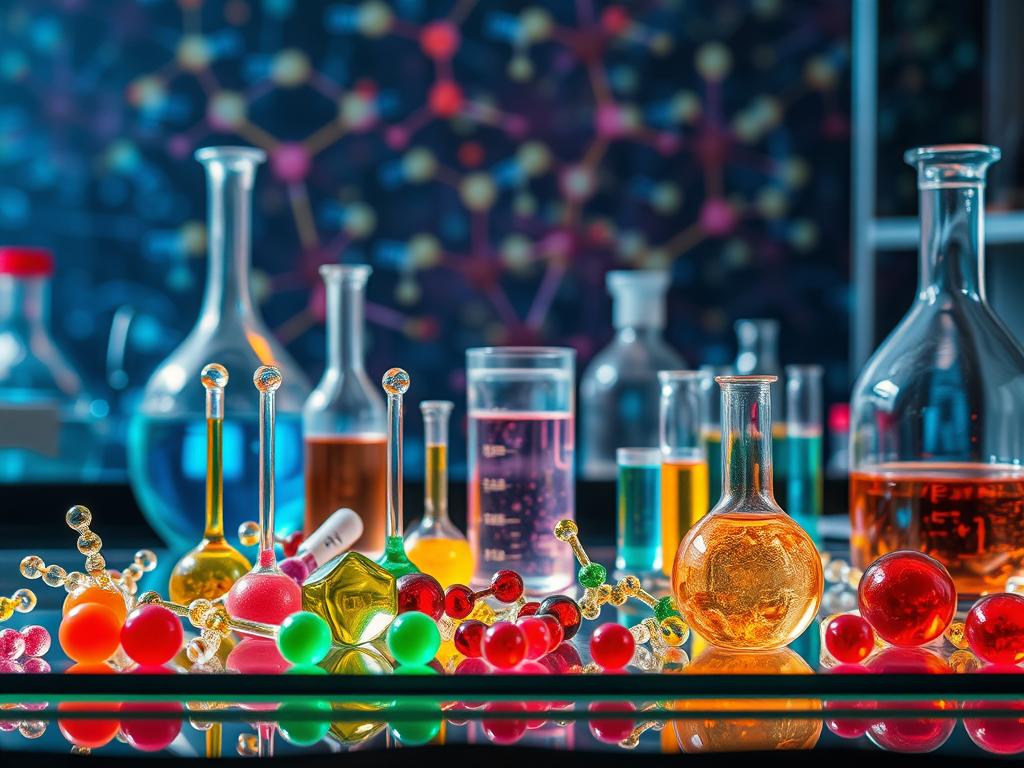Heterogeneous Catalysis in Inorganic Synthesis

Welcome to an exciting journey into the world of Heterogeneous Catalysis in Synthesis! We’ll explore how catalytic reactions are changing Inorganic Synthesis. You’ll see how new catalysts, like Pd@HQBI-SPION, are changing carbon-carbon bond formations.
You’ll learn about palladium on superparamagnetic iron oxide nanoparticles (Pd@HQBI-SPION). These catalysts are very good at many reactions. We’ll also look at how scientists use FTIR, TEM, and magnetic measurements to check these catalysts.

Let’s discover the latest in Heterogeneous Catalysis in Synthesis. We’ll see how these new systems are changing Inorganic Synthesis. This journey will make you curious about the amazing Catalytic Processes of the future.
Understanding the Fundamentals of Catalytic Processes
Exploring the surface chemistry that drives heterogeneous catalysis is key. It helps us understand how catalysts and reactants interact. This interaction shapes the outcome of reactions and their efficiency.
Basic Principles of Surface Chemistry
The surface of catalysts plays a crucial role. Knowing about surface structure, adsorption, and desorption is essential. These factors affect how well a catalyst works and what it can do.
Role of Catalyst Support Materials
Catalyst support materials, like superparamagnetic iron oxide nanoparticles (SPION), are vital. They help spread out active parts of the catalyst, improve stability, and make it easier to reuse. SPIONs can also help in creating new reactions and reducing certain chemicals.
Kinetics and Reaction Mechanisms
Understanding the kinetics and mechanisms of catalytic reactions is crucial. It helps us make these reactions more efficient and specific. Knowing about key steps, interactions, and the role of certain substances can guide us in designing better catalysts.
| Parameter | Value |
|---|---|
| Surface Area | 100 m²/g |
| Pore Volume | 0.5 cm³/g |
| Pore Size | 10 nm |
| Particle Size | 20 nm |
By studying surface chemistry, support materials, and reaction kinetics, we can unlock the full potential of heterogeneous catalysis. This knowledge drives innovation in many synthetic processes.
Evolution of Heterogeneous Catalysis
The history of heterogeneous catalysis started with Charles Cagniard de la Tour in the 19th century. Over time, it has grown a lot. New discoveries have changed how we make chemicals and run industries.
Vladimir Ipatiev, a Russian chemist, was a big step forward. He used high-pressure vessels for reactions. This led to making more fuels and chemicals on a large scale.
Then, supercritical fluids like carbon dioxide changed things. Kurt Zosel showed how to use CO2 for decaffeinating coffee. Now, these fluids help in many fields, from making polymers to drugs.
Today, we focus more on being green and safe. We use cleaner solvents and make reactions better. This is a big part of the research now.
New tools and computer models have helped a lot. We know more about how catalysts work. This lets us make better, more specific catalysts.
The future looks bright for heterogeneous catalysis. We’ll see new materials, better reactors, and greener ways to make chemicals. This will change what we know about green chemistry.
| Historical Development | Catalytic Innovations | Supercritical Fluids | Green Chemistry |
|---|---|---|---|
|
|
|
|
The history of heterogeneous catalysis is filled with big steps. We’ve seen Historical Development, Catalytic Innovations, the use of Supercritical Fluids, and a push for Green Chemistry. As we keep exploring, the future looks very promising for making chemicals better and greener.
 Advanced Inorganic Materials: Synthesis and Properties
Advanced Inorganic Materials: Synthesis and Properties
Characterization Techniques for Heterogeneous Catalysts
Understanding the structure and performance of heterogeneous catalysts is key. Inorganic chemistry provides advanced tools for this. These tools give insights into the properties and behavior of these materials.
Spectroscopic Methods
FTIR Spectroscopy is used to study the surface chemistry of catalysts. It helps understand how the catalyst works and the role of its components.
Microscopy and Surface Analysis
TEM Analysis gives detailed images of the catalyst’s shape and size. Surface Analysis methods, like Energy-Dispersive X-ray Spectroscopy (EDS), show the elements on the surface.
In-situ Characterization Tools
In-situ techniques, including Magnetic Measurements, study catalyst behavior under real conditions. They help monitor changes in the catalyst during the reaction. This allows for better reaction conditions and catalyst design.
Using a mix of these techniques is vital. It helps understand how the structure of a catalyst affects its activity. This knowledge is crucial for creating more efficient and selective catalysts.
Heterogeneous Catalysis in Synthesis: Modern Applications
In organic synthesis, heterogeneous catalysis is a game-changer. It makes creating complex carbon-carbon bonds easier and more precise. Gold nanoparticles on titanium dioxide are a great example. They help in making certain organic compounds.
These gold nanoparticles on titanium dioxide work very well. They produce high-quality results consistently. The size and shape of the nanoparticles matter a lot for their success.
This breakthrough is big news for making complex organic molecules. It’s good for the pharmaceutical and materials science fields. It shows how Carbon-Carbon Bond Formation, Nanocatalysts, and Green Synthesis can make industrial processes better and greener.
| Reaction Type | Yield | Selectivity |
|---|---|---|
| Tandem cyclization/reduction | Up to 95% | >20:1 |
| Tandem cyclization/hydroalkoxylation | Up to 92% | >20:1 |
The power of these catalysts in making complex molecules is huge. It shows the bright future of Nanocatalysts and Green Synthesis in Industrial Applications. As research goes on, we’ll see even more amazing things in organic synthesis.
Design and Development of Nanocatalysts
The creation of nanocatalysts is key in today’s catalysis research. It’s important to control the size and shape of nanoparticles for the best results. Methods like attaching HQBI ligands to SPION and immobilizing palladium have shown great promise.
Adatoms and small gold nanoclusters are getting a lot of attention. They help bridge homogeneous and heterogeneous catalysis. Creating controlled shapes and bimetallic nanoparticles can boost catalytic activity. These materials have unique properties at their surfaces, like steps, edges, and corners.
Size and Shape Control
Getting the size and shape of nanoparticle catalysts just right is essential. New synthetic methods allow for making metal nanoparticles in specific shapes, like cubes, rods, and octahedra. Each shape has its own set of catalytic properties.
Surface Modification Strategies
Changing the surface of metal nanoparticles can make them work better. Methods like attaching HQBI ligands to SPION and immobilizing palladium have shown promise. These strategies are crucial for making efficient nanocatalysts.
| Technique | Yield Range | Average Yield |
|---|---|---|
| Tandem cyclisation/reduction of ortho-alkynyl benzaldehyde derivatives with Au NPs/TiO2 | 45-98% | 70.4% |
| Tandem cyclisation/hydroalkoxylation of ortho-alkynyl benzaldehyde derivatives with Au NPs/TiO2 | 62-96% | 84.9% |
Sustainable Chemistry Through Heterogeneous Catalysis
Heterogeneous catalysis is key to a greener future. It helps create eco-friendly processes that cut down waste and save resources. This field, from Green Catalysis to Sustainable Synthesis, is always growing. It’s driven by the need for Eco-friendly Processes.
Supercritical fluids like carbon dioxide (CO2) and water are big in this field. They help in many ways, like better mass transfer and mild conditions. This makes heterogeneous catalysts work better, reducing waste and improving efficiency.
| Catalyst Property | Advantage in Sustainable Chemistry |
|---|---|
| Recyclability | Minimizes waste and resource consumption |
| Reduced Metal Leaching | Prevents contamination and improves product purity |
| Continuous Flow Reactions | Enhances process efficiency and scalability |
Heterogeneous catalysis also helps make biofuels and process biomass. It uses special catalyst properties to find new ways to use renewable energy and waste biomass.
 Structure and Bonding in Coordination Compounds
Structure and Bonding in Coordination Compounds
As we aim for a sustainable future, Green Catalysis and Sustainable Synthesis are crucial. They make chemical processes more efficient and environmentally friendly. This is a big step towards a better world.
Industrial Scale Applications and Reactor Design
Scaling up catalytic processes from labs to big industries is tough. But, new reactor designs and process improvements have made it possible. Let’s look at how these advancements are helping in Industrial Catalysis.
Continuous Flow Systems
Continuous flow systems are a key for big-scale Reactor Engineering. They improve heat and mass transfer and control over reactions. For example, a tandem reaction was scaled up ten times in a continuous flow reactor. It kept high efficiency, with a 99% conversion rate in just 10 minutes.
Batch Reactor Optimization
Batch reactors are also vital for Process Intensification in Scale-up. Making batch reactors work better is key for high yields. A carbene insertion reaction was optimized to get a high space-time yield, much better than before.
Supercritical fluids are also being looked into for industrial use. They offer new chances for Industrial Catalysis.
Thanks to new Reactor Engineering and Process Intensification advances, the chemical industry is opening up new ways. This will help in scaling up catalytic processes and finding new Industrial Catalysis solutions.
Selective Oxidation and Reduction Reactions
Heterogeneous catalysis is key in selective oxidation and reduction. It helps make fine chemicals and valuable compounds efficiently. Gold (Au) nanoparticles are used in cyclization and reduction of ortho-alkynyl benzaldehyde derivatives. Hantzsch ester acts as the reducing agent.
These reactions show high selectivity, making only 6-endo products. The reason is the complex mix of electronic effects and substituent influence. By adjusting the catalyst and conditions, scientists have made these reactions useful for creating bioactive compounds and other valuable chemicals.
| Reaction | Selectivity | Applications |
|---|---|---|
| Catalytic Oxidation | High selectivity for 6-endo products | Synthesis of bioactive compounds and fine chemicals |
| Selective Reduction | Exclusive formation of desired products | Versatile platform for fine chemical synthesis |
| Redox Catalysis | Excellent control over reaction outcomes | Potential for scalable production of high-value chemicals |
These selective oxidation and reduction reactions help us understand heterogeneous catalysis better. They also open doors to more efficient and green ways to make fine chemical synthesis.
Catalyst Recovery and Recycling Methods
In the world of sustainable catalysis, it’s key to recover and recycle catalysts well. Magnetic nanoparticles, like superparamagnetic iron oxide nanoparticles (SPIONs), are a great solution. They can be pulled out of mixtures with magnets, making it easy to reuse valuable catalysts.
Magnetic Separation Techniques
Magnetic separation uses the special properties of these nanoparticles to make recovering catalysts easier. By adding these nanoparticles to the catalyst, it’s simple to separate the whole system from the mix. This method boosts the sustainability of the process, cuts down on waste, and lessens environmental harm.
Regeneration Protocols
Keeping the catalyst active and effective over many uses is vital for sustainable catalysis. Regeneration methods, like heat treatments or chemical processes, help keep the Magnetic Nanoparticles working well. By designing these methods carefully, the catalyst can be used again and again, making the process more efficient and saving resources.
Combining magnetic separation with effective regeneration methods leads to a circular economy in catalysis. This not only makes catalytic processes more cost-effective but also supports Sustainable Chemistry. It helps create a greener, more efficient future.
Future Trends in Heterogeneous Catalysis Research
The world faces big challenges like finding sustainable energy and cleaning the environment. Heterogeneous catalysis is key to solving these problems. New Catalytic Technologies, thanks to Nanomaterials and Computational Catalysis, will change how we tackle these issues.
New Nanomaterials as catalysts could be very powerful. These tiny materials can start complex reactions with great accuracy. This could lead to cleaner and greener ways to make things. For example, turning CO2 into useful chemicals is now possible.
At the same time, using computers to design catalysts is making big strides. This lets scientists predict and test new materials quickly. Computational Catalysis is opening up new areas in making chemicals, biofuels, and more.
The History of the Great Barrier Reef: Formation, Biodiversity, and Conservation





